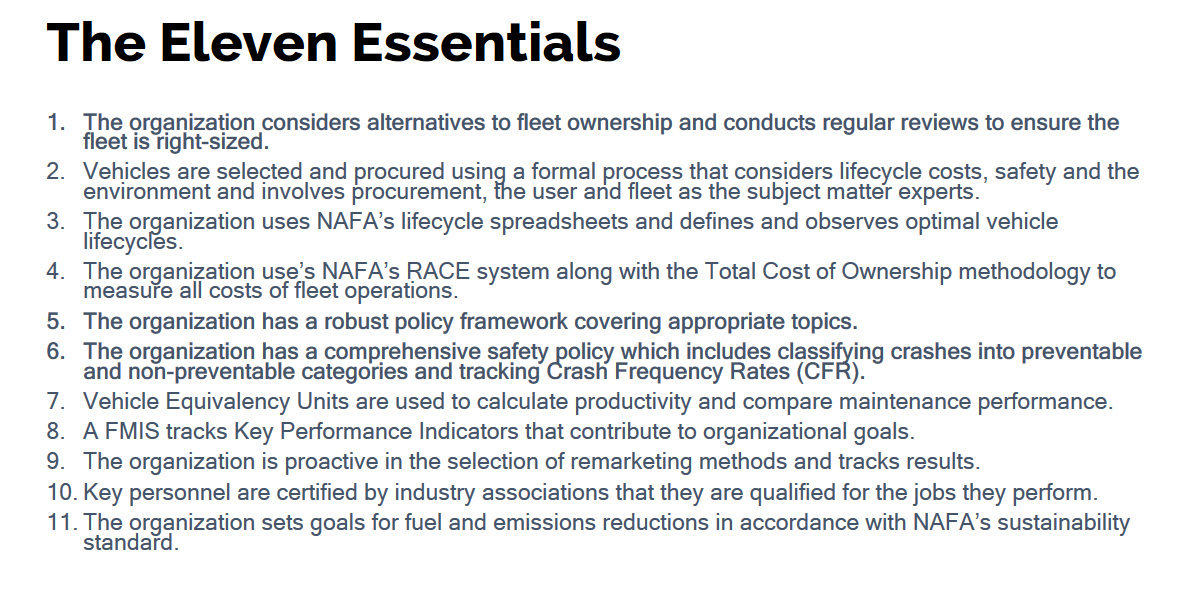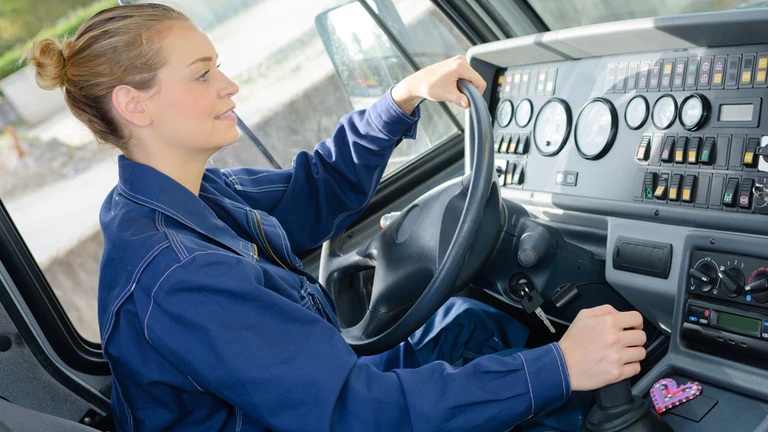Experts recently discussed ways to correctly size fleets and other ways to improve efficiency, how women can make fleets safer, and tech that literally will unlock your assets.
When looking to start optimizing fleet efficiency, sometimes simpler is better, suggested Kate Vigneau director of professional development at the NAFA Fleet Management Association, on a recent FleetOwner webinar called “The Key to Fleet Efficiency, Driver Safety and Recruitment.” It was sponsored by Irdeto.
Instead of stringing together a complicated web of data from which to benchmark, fleets should refer to NAFA’s 11 Essentials for Fleet Management, Vigneau said.
“In order to do benchmarking properly, you need a ton of very accurate data and a lot of experience, and you need both of these things in order to be able to account for the differences between organizations,” she said. “Without either the data or the experience, benchmarks are virtually useless.”
So the best method for newer fleet managers starting to optimize their fleets is to refer to NAFA’s guiding principles that have been in effect for about five years.
Here they are:
 NAFA Fleet Management’s 11 essentials
NAFA Fleet Management’s 11 essentials
Vigneau, former fleet manager for Canada’s Department of National Defence, said, “If you’re doing these things, you’re probably OK.”
She recommended performing an annual utilization study and logging when trucks are replaced to right-size fleets and avoid “fleet creep,” a dynamic in which the overall size of a fleet slowly grows over time.
One needn’t always replace an aging truck with the same size, as well. This is where right-typing plays a big role.
“It’s human nature to think bigger is better: ‘I want the SUV even though a sedan will fit the bill.’” Vigneau explained. The same is true in large fleets. Making a decision tree can help a fleet manager ensure the most efficient mobility solution is deployed, she said.
Regarding safety and crash reporting, Vigneau, who spent 26 years in the Canadian Army in various logistical positions at home and abroad, told a “war story” to illustrate her point
A driver headed down a precarious mountainside in bad weather after a drop off at the top, ultimately lost control, and had to abandon the truck before it tumbled down the mountain.
“When I got the crash report, it was literally classified as a non-preventable crash,” she recalled, with the rationale that the driver was out of the vehicle when it fell. In short, context matters.
“If crashes are not properly classed as preventable or non-preventable, there’s no impetus to identify the underlying causes and prevent them,” she said.
Recruiting Women Drivers
Following Vigneau’s portion, Ellen Voie, the president and CEO of Women in Trucking, provided some data to support women gaining a more prominent representation in trucking because they are safer. The organization’s mission is to promote female employment in the trucking industry, recognize their achievements and remove current barriers.
According to a 2018 American Transportation Research Institute study, “women truck drivers were safer than their male counterparts in every statistically significant safety behavior and male drivers were 20% more likely to be involved in a crash than women,” Voie stated.
Why is that?
“Women take fewer risks, men are more likely to be involved in crashes on curves, in the dark, or passing other vehicles,” Voie said. “Accidents involving women typically occur at slower speeds, which means there’s less loss of life and less damage to the equipment.”
One reason for this, Voie, reasoned, was that women are “more risk-averse” due to biological differences: “Women activate the amygdala, which is the fear [center of the brain], more easily than men.”
Voie also said because women have more estrogen, they are driven to “discourage conflict,” while the higher levels of testosterone in males “encourages the focus on winning and demonstrating power.”
Women in Trucking was “thrilled” such a causation study was broken up demographically, Voie said. When the organization was created 15 years ago, gender-related data was not available because women were not considered a statistically significant demographic.
Voie added women were generally more likely to correctly fill out paperwork and keep on maintenance, according to what she often hears, though could not quantify. Solid Omnitracs data did reveal women drivers accumulated more miles than male counterparts.
A recent survey by the group, which canvassed 884 fleets, found that women comprise 10% of driver fleets. These women are an average age of 50. Voie specified these were over-the-road drivers. Women fill less than 25% of management roles and a paltry 5% of diesel technicians. [For an in-depth look at the female diesel tech disparity, read our feature on the issue here.]
As previously mentioned, Women in Trucking seeks to minimize and eliminate the obstacles placed in front of female drivers on the road to success. A few that can be solved by things such as adding women’s restrooms to the facility and ordering female sizes of uniforms. Arguably, however, more things must be removed, like a feeling of vulnerability.
“We did a best practices research and we asked female drivers how safe they feel on a scale of one to 10— and unfortunately, the response was 4.4,” Voie said.
It’s a staggering statistic all fleets and shops should seek to address if they hope to retain these safer, productive drivers.
“How would you feel if less than half of the time when you went to work you felt safe?” asked Voie.
The underlying cause of women feeling unsafe has to do with equipment. Voie said having well-maintained equipment is a top priority for women. More ergonomically suited equipment will also help women stay in the profession, as a top point of dissatisfaction on the job deals with the tractors.
Women have shorter appendages and wider hips, so they need dashes and seats that provide comfort and visibility. Ensuring the hood has a hydraulic assist is another factor, as is ensuring inside the sleeper cab there is ample storage and bunks are easily accessible.
“It’s more looking at the cab as their home and not their workplace,” Voie said.
The overall safety culture is also crucial. Regardless of gender, a strong safety culture includes drivers of either gender being able to pull over in bad weather or avoid delivering to a city with the potential for riots. Fleet managers should also consider whether they are asking drivers to make deliveries at night in unsafe areas.
The final key
At the conclusion, Irdeto, which sponsored the webinar, provided an explanation of its Keystone digital key technology. This provides several advantages, one of which ties directly to women feeling unsafe.
“There’s often too many fleets that have a one key approach for their for their entire fleet,” said Ryan Ward, technical account manager for Irdeto. “Although that increases efficiency, it unfortunately brings along some risks to the driver…which are sexual harassment and assault.”
If a woman feels a sleeper cab is her home, then a fleet with a universal key means anyone and everyone has access to her bedroom.
Driver-specific keys, and the ability to digitally revoke permissions after a maintenance job, for example, would arguably increase the feeling of security for all drivers.
Some other benefits include:
- Sending and collecting keys remotely over the air
- Sending keys automatically upon booking and payment (for truck rentals) or prior to start of shift
- Ability to pre-condition a vehicle when a valid key holder is approaching it
- Fleet status data
- Ability to revoke and replace lost or misplaced keys
- Improve low utilization rates
- Shorten pre-checks
- Simplify scheduling maintenance
By John Hitch
Source: https://www.fleetowner.com
CUT COTS OF THE FLEET WITH OUR AUDIT PROGRAM
The audit is a key tool to know the overall status and provide the analysis, the assessment, the advice, the suggestions and the actions to take in order to cut costs and increase the efficiency and efficacy of the fleet. We propose the following fleet management audit.




